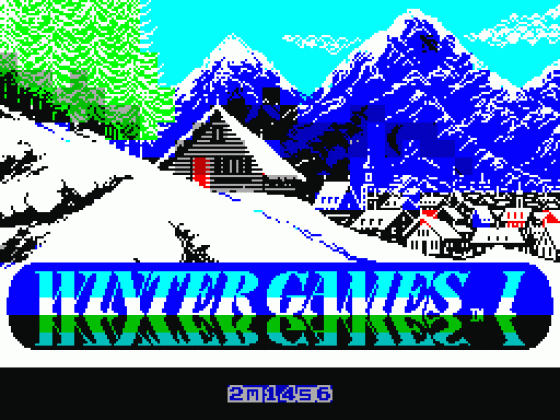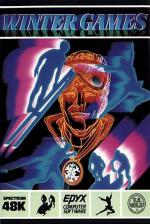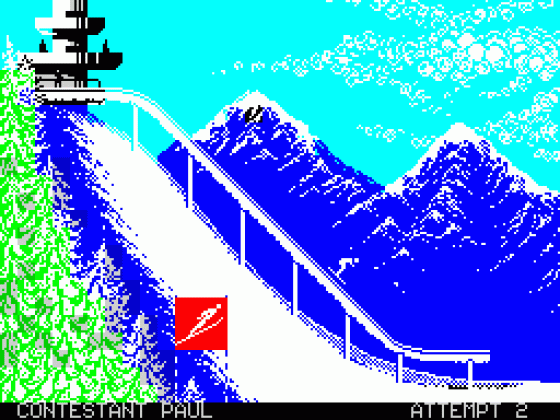
Crash
 1st March 1986
1st March 1986
Categories: Review: Software
Author:
Publisher: U. S. Gold
Machine: Spectrum 48K/128K
Published in Crash #26
Winter Games
Wrap up in your bright red skiing gear, don your skates and go out on the piste courtesy of Winter Games. Yupsirree sporting fans, the latest Epyx/US Gold sports simulation prematurely brings to your Spectrum's screen seven of the events which will feature in the 1988 Winter Olympics in Calgary, Canada.
The events fall into three categories: skating events, figure, free and speed; skiing, hot dogging, the jump and biathalon; and finally sledding - bobsled. All these events won't fit into memory together, and two loads are required. The package includes a double-sided cassette with three events on one side and four on the other. Each side can be loaded independently.
Once a side has loaded an extensive options screen is presented. Using this, you can change the game controls, see the world records and choose the number of players participating - up to four people can compete together. Events can be practised, and it's possible to compete in single events or run through all the events loaded from one side. When the game has been set up to your satisfaction you're asked to input your name and play begins.

SIDE ONE: Ski Jumping, Hot Dog Aerials and Speed Skating
Speed Skating involves a 30 mph dash over a smooth glassy surface. The screen is split horizontally, each half showing two skating lanes and competitors race against a computer-controlled pacer on their half of the screen. The idea is to whizz off as fast as you can once the starting signal sounds, in an attempt to get to the finishing post first.
To control your skater, all you have to do is press left and right rhythmically in time with your skater's legs, quickly at the beginning to build up speed, then slowly and smoothly to keep the speed up once it has been attained. A bar display on the right of the lanes gives a speed readout. Naturally, the player with the fastest time wins the race.
The Ski Jump sees you at the top of a long runway, and the ground looks far, far away. Pressing fire starts the journey down the slope, and another press at the end of the runway makes your skier leap into space - mistime this, and the skier takes a tumble. If the jump is timed right, then the screen changes, revealing the skier's flightpath as he falls towards the landing slope and stopping area. In the upper right hand corner of this screen a little window shows the skier's posture in the air. To make good jump, you need to watch this window, correcting the skier's faults in mid-air. Up unbends the skier's kness, down stops the skis from crossing and left and right is used to adjust the angle of forward and backward lean. If corrections aren't made then presentation points are lost, the skier doesn't travel so far and a crash landing is likely, and more points are lost.
The distance jumped is multipled by three and added to the presentation marks to give an overall score. Each player has three attempts to notch up a good score before the winner of the event is announced.
Hot Dog Aerials is the third event on Side One. In this crazy event a skier has to whizz down a short runway, take off and perform as many stunts, somersaults and kicks as possible before landing safely. Like the Ski Jumping, the skier is activated by a press of the fire button. Once in the air, six directional controls select the stunts that can be performed. Since the jump is a short one there's only time for two stunts - any more and the hotdogger is likely to land head-first! Points are awarded for the difficulty of the stunts performed: the more complex the routine, the higher the points. Once again, you get three attempts but, in this skiing event, a panel of international judges award points, which are then averaged.
SIDE TWO: Figure Skating, Free Skating, Bobsled and The Biathalon
The two skating events are very similar indeed and have indentical control methods and graphics - in Figure Skating seven compulsory moves have to be made whilst in Free Skating it's up to you to choreograph your own performance.
The Figure Skating event lasts for one minute, and skating against the timer, you have to complete a program of seven movements. Your skater is shown in the centre of the screen with the crowd scrolling past in the background. A timer ticks down during your performance.
Figure skaters are capable of eight different moves, including skating forwards. Practice and experimentation are needed before you become proficient at these events. Learning which move can succesfully follow on from another without risk of your skater taking a tumble is vital. When a minute is up your skater takes a bow and a score is given. Points are awarded for successful movements - awkward movements and falls cost points.
Free Skating looks and plays identically to the figure skating, only there is a time limit of two minutes. In this event the overall object is to make three successful attempts at the seven moves. Once again, points are won for each movement completed and lost for mistakes and falls. The highest possible score is a six, no matter what your overall score.
The Biathalon is the most strength sapping of all the events... with a .22 calibre rifle over your shoulder you have to endure ice and snow as you race against the clock over scenic landscapes pausing for a spot of target shooting on the way. The course consists of several flip screens showing slopes, flat stretches and the four target boards. Each target screen contains five targets and a sight moves vertically over each one in turn. Your athlete's pulse rate, monitored by a flashing heart on the bottom right of the screen, affects the steadiness of your aim. You get one shot at each target - aim carefully as a miss adds a five second penalty to the overall time for the event.
Fluent left/right movements on the joystick or keys moves the biathlete across the snow on the level and uphill stretches. If you go too fast he slips; go too slowly and it takes ages to build up a good speed. Digging your ski sticks into the snow adds speed on the downhill slopes. At the end of the course your overall time, less penalties, is displayed.
The final event on Side Two puts you in the driving seat of a bobsled. In order to retain control of the sled you have to steer left and right in the bends. The screen is divided into three, with the biggest area taken up by an aerial plan of the course. Once you start racing a red line creeps down the course showing your progress, helping you to anticipate bends. The second screen area gives a view of the track as you belt down it, and is the most important screen since it allows you to gauge whether the bob is being oversteered or understeered. If you don't steer the sled properly then it tumbles over. The third screen is the timer which you race against... and as in real life fractions of a second count.
After every event Gold, Silver and Bronze medals are given and points awarded accordingly to the medal wnners. After all the events have been played on one side, the player with the highest points is acclaimed the champion of the games.
Winter Games also has a World Record facility. If you get a record during a game then it'll automatically be included in the record tables which can be viewed using the option screen. Unfortunately the table can't be saved, but at least you can note down your best efforts, or throw down a challenge to your chums. Don't be too disappointed if you can't find the Opening Ceremony mentioned in the large instruction sheet - the programmers couldn't quite fit it in, and an Errata slip should come in the package apologising for this omission.
Comments
Control keys: definable
Joystick: Kempston, Cursor, Interface 2
Keyboard play: nice and easy
Use of colour: good
Graphics: very good, especially some of the backdrops
Sound: some good tunes
Skill levels: one, improve your scores!
Screens: one for each event, two for the Ski Jump, and a course made up from three flip screens for the Biathlon
Comment 1
'Seven events in only two loads for only eight quid can't be bad. I wasn't impressed with the menu and medal screens, but the game itself is very good with beautiful backgrounds on most of the outdoor events. Side One is the best graphically, with sound on the events too, but Side Two features four events - it's hard to decide which side to play. All the events require a fair amount of practice, some more than others - the skating and ski-jumping, for instance, need a lot of accurate joystick or keyboard control and split-second timing. Every event is of very high quality, and just when you think you've gone as far as you can, you find some other special move. With the snow gently descending in Ludlow, I'm glad I can get some skating practice in!'
Comment 2
'I reckon this must be the best sports game to date, with the possible exception of Hyper Sports. Seven excellently portrayed events make for great fun, and because of the constantly appealing challenge about beating the record, or trying a different event, this is a highly addictive piece of software. Some of the events take some getting into, others are instantly playable but the difficulty still remains. The instructions are very long and helpful, telling you everything about each event, and detailing a history of the Winter Games as well. Epyx seem to have succeeded where Electric Dreams failed with their Winter Sports. I think the name similarity could confuse, which would be very unfortunate. I now live in hope of seeing a Spectrum version of Summer Games (I and II). Over to you US Gold/Epyx.'
Comment 3
'The cover looks great and the games inside are mega-great. All these highly dangerous winter sports can now be played in the comfort of your own home without the risk of breaking bones! The seven different events kept me glued to the keyboard for hours on end. The graphics are lovely throughout, with beautiful lodges and scenery - David Thorpe (see ON THE COVER, Issue 17) has done a great job. Some of the games are really fast - you need to be really quick with your reflexes. All in all, a great package.'
Other Reviews Of Winter Games For The Spectrum 48K/128K
Winter Games (US Gold)
A review by Gwyn Hughes (Your Sinclair)
Winter Games 128K (US Gold)
A review by Rachael Smith (Your Sinclair)
Winter Games (US Gold/Epyx)
A review by John Gilbert (Sinclair User)
Winter Games (Epyx)
A review by John Gilbert (Sinclair User)
Winter Games (US Gold/Epyx)
A review
The Spectrum Collection: Update
One year on from the Spectrum Collection, Tony Hetherington picks the best Spectrum games
Winter Games Vs. Winter Sports (Electric Dreams)
A review













